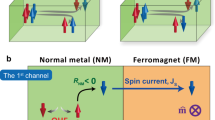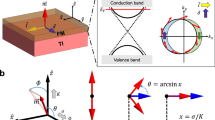Abstract
Spin–orbit torques enable energy-efficient manipulation of magnetization by electric current and hold promise for applications ranging from non-volatile memory to neuromorphic computing. Here we report the discovery of a giant spin–orbit torque induced by anomalous Hall current in ferromagnetic conductors. This anomalous Hall torque is self-generated as it acts on the magnetization of the ferromagnet that engenders the torque. The magnitude of the anomalous Hall torque is sufficiently large to fully negate magnetic damping of the ferromagnet, which allows us to implement a microwave spin torque nano-oscillator driven by this torque. The peculiar angular symmetry of the anomalous Hall torque favours its use over the conventional spin Hall torque in coupled nano-oscillator arrays. The universal character of the anomalous Hall torque makes it an integral part of the description of coupled spin transport and magnetization dynamics in magnetic nanostructures.
This is a preview of subscription content, access via your institution
Access options
Access Nature and 54 other Nature Portfolio journals
Get Nature+, our best-value online-access subscription
27,99 € / 30 days
cancel any time
Subscribe to this journal
Receive 12 print issues and online access
269,00 € per year
only 22,42 € per issue
Buy this article
- Purchase on SpringerLink
- Instant access to full article PDF
Prices may be subject to local taxes which are calculated during checkout




Similar content being viewed by others
Data availability
All data generated or analysed during this study are included in this published article and are available from the corresponding author on reasonable request. Source data are provided with this paper.
References
Liu, L. et al. Spin-torque switching with the giant spin Hall effect of tantalum. Science 336, 555–558 (2012).
Haidar, M. et al. A single layer spin–orbit torque nano-oscillator. Nat. Commun. 10, 2362 (2019).
Demidov, V. E. et al. Magnetic nano-oscillator driven by pure spin current. Nat. Mater. 11, 1028–1031 (2012).
Liu, L., Pai, C.-F., Ralph, D. C. & Buhrman, R. A. Magnetic oscillations driven by the spin Hall effect in 3-terminal magnetic tunnel junction devices. Phys. Rev. Lett. 109, 186602 (2012).
Duan, Z. et al. Nanowire spin torque oscillator driven by spin orbit torques. Nat. Commun. 5, 5616 (2014).
Litvinenko, A. et al. Ultrafast GHz-range swept-tuned spectrum analyzer with 20 ns temporal resolution based on a spin-torque nano-oscillator with a uniformly magnetized ‘free’ layer. Nano Lett. 22, 1874–1879 (2022).
Seifert, T. et al. Efficient metallic spintronic emitters of ultrabroadband terahertz radiation. Nat. Photonics 10, 483–488 (2016).
Ando, K. et al. Electric manipulation of spin relaxation using the spin Hall effect. Phys. Rev. Lett. 101, 036601 (2008).
Huang, X. et al. Novel spin–orbit torque generation at room temperature in an all-oxide epitaxial La0.7Sr0.3MnO3/SrIrO3 system. Adv. Mater. 33, 2008269 (2021).
Wadley, P. et al. Electrical switching of an antiferromagnet. Science 351, 587–590 (2016).
Yan, G. Q. et al. Quantum sensing and imaging of spin–orbit-torque-driven spin dynamics in the non-collinear antiferromagnet Mn3Sn. Adv. Mater. 34, 2200327 (2022).
Higo, T. et al. Perpendicular full switching of chiral antiferromagnetic order by current. Nature 607, 474–479 (2022).
Miron, I. M. et al. Perpendicular switching of a single ferromagnetic layer induced by in-plane current injection. Nature 476, 189–193 (2011).
Petrović, M. D., Mondal, P., Feiguin, A. E., Plecháč, P. & Nikolić, B. K. Spintronics meets density matrix renormalization group: quantum spin–torque-driven nonclassical magnetization reversal and dynamical buildup of long-range entanglement. Phys. Rev. X 11, 021062 (2021).
Hache, T. et al. Bipolar spin Hall nano-oscillators. Appl. Phys. Lett. 116, 192405 (2020).
Hamadeh, A. A. et al. Simultaneous multitone microwave emission by DC-driven spintronic nano-element. Sci. Adv. 9, eadk1430 (2023).
Woo, S. et al. Observation of room-temperature magnetic skyrmions and their current-driven dynamics in ultrathin metallic ferromagnets. Nat. Mater. 15, 501–506 (2016).
Li, P. et al. Charge–spin interconversion in epitaxial Pt probed by spin–orbit torques in a magnetic insulator. Phys. Rev. Mater. 5, 064404 (2021).
Ikebuchi, T., Shiota, Y., Ono, T., Nakamura, K. & Moriyama, T. Crystal orientation dependence of spin Hall angle in epitaxial Pt/FeNi systems. Appl. Phys. Lett. 120, 072406 (2022).
Safranski, C., Sun, J. Z., Xu, J.-W. & Kent, A. D. Planar Hall driven torque in a ferromagnet/nonmagnet/ferromagnet system. Phys. Rev. Lett. 124, 197204 (2020).
Pauyac, C. O., Chshiev, M., Manchon, A. & Nikolaev, S. A. Spin Hall and spin swapping torques in diffusive ferromagnets. Phys. Rev. Lett. 120, 176802 (2018).
Belashchenko, K. D., Kovalev, A. A. & van Schilfgaarde, M. Interfacial contributions to spin–orbit torque and magnetoresistance in ferromagnet/heavy-metal bilayers. Phys. Rev. B 101, 020407 (2020).
Hibino, Y. et al. Giant charge-to-spin conversion in ferromagnet via spin–orbit coupling. Nat. Commun. 12, 6254 (2021).
Lee, D. et al. Orbital torque in magnetic bilayers. Nat. Commun. 12, 6710 (2021).
Safranski, C. et al. Spin caloritronic nano-oscillator. Nat. Commun. 8, 117 (2017).
Garello, K. et al. Symmetry and magnitude of spin–orbit torques in ferromagnetic heterostructures. Nat. Nanotechnol. 8, 587–593 (2013).
Dc, M. et al. Observation of anti-damping spin–orbit torques generated by in-plane and out-of-plane spin polarizations in MnPd3. Nat. Mater. 22, 591–598 (2023).
Gibbons, J. et al. Large exotic spin torques in antiferromagnetic iron rhodium. Phys. Rev. Appl. 18, 024075 (2022).
Romera, M. et al. Binding events through the mutual synchronization of spintronic nano-neurons. Nat. Commun. 13, 883 (2022).
Bender, S. A. & Tserkovnyak, Y. Thermally driven spin torques in layered magnetic insulators. Phys. Rev. B 93, 064418 (2016).
Amin, V. P., Haney, P. M. & Stiles, M. D. Interfacial spin–orbit torques. J. Appl. Phys. 128, 151101 (2020).
Gonçalves, A. M. et al. Spin torque ferromagnetic resonance with magnetic field modulation. Appl. Phys. Lett. 103, 172406 (2013).
Safranski, C., Montoya, E. A. & Krivorotov, I. N. Spin–orbit torque driven by a planar Hall current. Nat. Nanotechnol. 14, 27–30 (2019).
Duan, Z. et al. Spin-wave modes in permalloy/platinum wires and tuning of the mode damping by spin Hall current. Phys. Rev. B 90, 024427 (2014).
Ochoa, H., Zarzuela, R. & Tserkovnyak, Y. Self-induced spin-orbit torques in metallic ferromagnets. J. Magn. Magn. Mater. 538, 168262 (2021).
Slavin, A. & Tiberkevich, V. Nonlinear auto-oscillator theory of microwave generation by spin-polarized current. IEEE Trans. Magn. 45, 1875–1918 (2009).
Demidov, V. E. et al. Control of magnetic fluctuations by spin current. Phys. Rev. Lett. 107, 107204 (2011).
Amin, V. P., Li, J., Stiles, M. D. & Haney, P. M. Intrinsic spin currents in ferromagnets. Phys. Rev. B 99, 220405(R) (2019).
Taniguchi, T., Grollier, J. & Stiles, M. D. Spin-transfer torques generated by the anomalous Hall effect and anisotropic magnetoresistance. Phys. Rev. Appl. 3, 044001 (2015).
Céspedes-Berrocal, D. et al. Current-induced spin torques on single GdFeCo magnetic layers. Adv. Mater. 33, 2007047 (2021).
Liu, E. et al. Giant anomalous Hall effect in a ferromagnetic kagome-lattice semimetal. Nat. Phys. 14, 1125–1131 (2018).
Nakatsuji, S., Kiyohara, N. & Higo, T. Large anomalous Hall effect in a non-collinear antiferromagnet at room temperature. Nature 527, 212–215 (2015).
Awad, A. A. et al. Long-range mutual synchronization of spin Hall nano-oscillators. Nat. Phys. 13, 292–299 (2017).
Hassan, O., Faria, R., Camsari, K. Y., Sun, J. Z. & Datta, S. Low-barrier magnet design for efficient hardware binary stochastic neurons. IEEE Magn. Lett. 10, 1–5 (2019).
Ryu, K.-S., Thomas, L., Yang, S.-H. & Parkin, S. Chiral spin torque at magnetic ___domain walls. Nat. Nanotechnol. 8, 527–533 (2013).
Emori, S., Bauer, U., Ahn, S.-M., Martinez, E. & Beach, G. S. D. Current-driven dynamics of chiral ferromagnetic ___domain walls. Nat. Mater. 12, 611–616 (2013).
Zhang, W. et al. Current-induced ___domain wall motion in a van der Waals ferromagnet Fe3GeTe2. Nat. Commun. 15, 4851 (2024).
Pham, V. T. et al. Fast current-induced skyrmion motion in synthetic antiferromagnets. Science 384, 307–312 (2024).
Barker, J. & Tretiakov, O. A. Static and dynamical properties of antiferromagnetic skyrmions in the presence of applied current and temperature. Phys. Rev. Lett. 116, 147203 (2016).
Gibbons, J. D., MacNeill, D., Buhrman, R. A. & Ralph, D. C. Reorientable spin direction for spin current produced by the anomalous Hall effect. Phys. Rev. Appl. 9, 064033 (2018).
Bose, A. et al. Observation of anomalous spin torque generated by a ferromagnet. Phys. Rev. Appl. 9, 064026 (2018).
Sun, C. et al. Field-free switching of perpendicular magnetization through spin Hall and anomalous Hall effects in ferromagnet–heavy-metal–ferromagnet structures. Phys. Rev. Appl. 12, 034022 (2019).
Wang, W. et al. Anomalous spin–orbit torques in magnetic single-layer films. Nat. Nanotechnol. 14, 819–824 (2019).
Kurebayashi, H. et al. An antidamping spin–orbit torque originating from the Berry curvature. Nat. Nanotechnol. 9, 211–217 (2014).
Zhu, L., Zhang, X. S., Muller, D. A., Ralph, D. C. & Buhrman, R. A. Observation of strong bulk damping-like spin–orbit torque in chemically disordered ferromagnetic single layers. Adv. Funct. Mater. 30, 2005201 (2020).
Liu, L. et al. Electrical switching of perpendicular magnetization in a single ferromagnetic layer. Phys. Rev. B 101, 220402(R) (2020).
Zheng, Z. et al. Field-free spin–orbit torque-induced switching of perpendicular magnetization in a ferrimagnetic layer with a vertical composition gradient. Nat. Commun. 12, 4555 (2021).
Hibino, Y., Taniguchi, T., Yakushiji, K., Kubota, H. & Yuasa, S. Observation of self-induced spin–orbit torques in Ni–Fe layers with a vertical gradient of magnetization. Phys. Rev. B 109, L180409 (2024).
Acknowledgements
We thank D. Nelson for deposition of the multilayers with NixFe100−x alloy composition gradient. This work was supported by the National Science Foundation (ECCS-2213690, X.P. and I.N.K.). Materials development for this project was supported by the National Science Foundation (DMREF-2324203, X.P. and I.N.K.). We acknowledge the use of facilities and instrumentation at the UC Irvine Materials Research Institute (IMRI), which is supported in part by the National Science Foundation through the UC Irvine Materials Research Science and Engineering Center (DMR-2011967, E.A.M. and X.P.). The use of facilities and instrumentation at the Integrated Nanosystems Research Facility (INRF) in the Samueli School of Engineering at the University of California Irvine is also acknowledged.
Author information
Authors and Affiliations
Contributions
E.A.M. and I.N.K. designed the study. E.A.M. formulated the experimental approach. X.P. and E.A.M. deposited the multilayer samples, performed device- and film-level experiments, developed the nanofabrication process and made the nanodevices. All authors wrote the paper and discussed the results.
Corresponding authors
Ethics declarations
Competing interests
The authors declare no competing interests.
Peer review
Peer review information
Nature Nanotechnology thanks Pedram Khalili Amiri and the other, anonymous, reviewer(s) for their contribution to the peer review of this work.
Additional information
Publisher’s note Springer Nature remains neutral with regard to jurisdictional claims in published maps and institutional affiliations.
Supplementary information
Supplementary Information
Supplementary Sections 1–12, Figs. 1 and 2, and Tables 1–4.
Source data
Source Data Fig. 1
Source data for Fig. 1c–e.
Source Data Fig. 2
Source data for Fig. 2a,b.
Source Data Fig. 3
Source data for Fig. 3a– c.
Source Data Fig. 4
Source data for Fig. 4b.
Rights and permissions
Springer Nature or its licensor (e.g. a society or other partner) holds exclusive rights to this article under a publishing agreement with the author(s) or other rightsholder(s); author self-archiving of the accepted manuscript version of this article is solely governed by the terms of such publishing agreement and applicable law.
About this article
Cite this article
Montoya, E.A., Pei, X. & Krivorotov, I.N. Anomalous Hall spin current drives self-generated spin–orbit torque in a ferromagnet. Nat. Nanotechnol. 20, 353–359 (2025). https://doi.org/10.1038/s41565-024-01819-7
Received:
Accepted:
Published:
Issue Date:
DOI: https://doi.org/10.1038/s41565-024-01819-7



